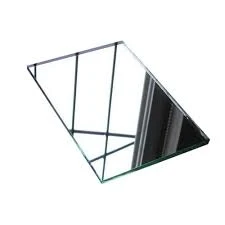

The Fascinating World of Grey Float Glass
Grey float glass, an essential material in the world of architecture and design, is renowned for its unique properties and versatility. This type of glass is characterized by its grey tint, which not only enhances aesthetics but also serves practical functions in various applications. To understand its significance, we must explore its composition, manufacturing process, benefits, and uses in modern society.
Composition and Manufacturing Process
Grey float glass is made from silica sand, soda ash, and limestone, combined with other additives to achieve the desired color and properties. The production process begins with melting these raw materials in a furnace at extremely high temperatures. Once melted, the glass is floated on a bed of molten tin, a process that gives it the term “float glass.” This technique creates a uniform thickness and smooth surface, essential for many applications. The introduction of iron oxide during the melting process imparts the grey hue, resulting in a material that is not only visually appealing but also functional.
After the float process, the glass is cooled slowly, allowing it to anneal, which reduces internal stresses and ensures durability. The final product can be cut, coated, or treated further to meet specific requirements for various uses.
Benefits of Grey Float Glass
One of the primary advantages of grey float glass is its ability to reduce glare and control solar heat gain. This quality is particularly beneficial in commercial and residential buildings, where large windows are common. By limiting the amount of light and heat that enters a space, grey float glass contributes to energy efficiency, helping to reduce cooling costs. Furthermore, its UV-filtering properties protect interiors from fading, thereby prolonging the life of furnishings and artwork.

Another significant benefit is the aesthetic appeal of grey float glass
. Its subtle shade adds elegance and sophistication to any structure while allowing for transparency and natural light. Grey float glass can harmonize beautifully with various architectural styles, making it a popular choice among architects and designers.Applications in Architecture and Design
The versatility of grey float glass has led to its widespread use in numerous applications. In commercial buildings, it is often utilized in façades, allowing for expansive views while maintaining privacy. The reflective quality of the glass can also enhance the appearance of the building, making it a popular choice for modern architecture.
In residential settings, grey float glass is commonly used in windows, sliding doors, and glass partitions. Its ability to blend seamlessly with various design elements makes it a favored option for contemporary homes. Additionally, grey float glass can be found in balustrades, shower enclosures, and tabletops, showcasing its versatility beyond traditional uses.
Moreover, the growing interest in sustainable design has resulted in an increased demand for grey float glass. Many manufacturers are now producing low-emissivity (Low-E) glass, which incorporates advanced coatings that improve energy efficiency. This innovation aligns with the global push for greener buildings and sustainability, making grey float glass an even more attractive option for eco-conscious architects and homeowners.
Conclusion
In conclusion, grey float glass represents a perfect fusion of functionality and aesthetics in modern architecture and design. Its unique properties—such as glare reduction, energy efficiency, and UV protection—make it an ideal choice for a wide array of applications. As the industry continues to evolve and prioritize sustainable practices, grey float glass is poised to maintain its status as a favored material in constructing beautifully designed and energy-efficient spaces. Whether used in residential or commercial environments, grey float glass exemplifies the seamless blend of beauty and practicality, highlighting its importance in contemporary architecture.